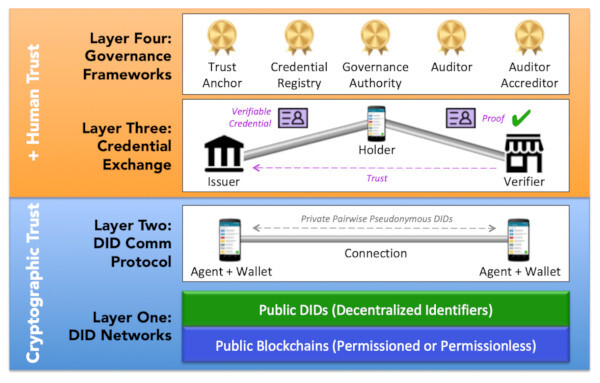I’m studying SSI, primarily the Hyperledger Indy/Aries stack.
These are two standard representations of the Indy/Aries stack, from the Evernym blog:

I have the impression that the goals aimed at by this stack can also be achieved by the DAML/Canton stack: private P2P communication, verifiable credential issuance, presentation and verification.
And also, the Identity Management part of the Canton documentation mentions “self-sovereign identity”:
“The identity management system is self-contained and built without a trusted central entity or pre-defined root certificate such that anyone can connect with anyone, without the need of some central approval and without the danger of losing self-sovereignty.”
So it seems to me that the DAML/Canton stack and the Indy/Aries stack wants to achieve the same goals differently, so they are rather competitors than complementing each other.
The “SSI” buzzword, like the “blockchain” buzzword directs attention the the Indy/Aries stack and away from alternatives which might be more flexible and business-friendly.
What do you think?
Can you see any parts of the SSI domain where the DAML/Canton stack falls behind?
3 Likes
Indy and Aries are purpose built for Digital Identity where Daml and Canton are tools that support building multi-party workflows. If you view Indy and Aries as both specifications and reference implementations, then you can start thinking about how Daml can be used to implement those specifications (and others) in the Digital ID space.
Using Daml to implement credential issuance and verification completely makes sense and you of course can leverage standards such as W3C in your Daml models. You can also implement a DID resolution service with a Daml based ledger which could provide similar functionality to Indy. You can also build integration adapters leveraging the Daml SDK that would provide interfaces to wallets and even implement Aries compatible interfaces if you desired. For Canton enabled ledgers, you can take advantage of the ability to reference credential information across different deployments natively which will be more efficient and less error prone than the message based interfaces typically found in systems today.
So in summary, believe Daml is a great tool to implement Digital Identity/Verifiable Credential systems with the added bonus of not locking you in to a specific standard or specification since the space will continue to evolve. At the heart of Digital Identify use cases are workflows which is where Daml shines. It is fairly trivial to model workflows and API interfaces that are compliant with various standards that are emerging while giving you the flexibility to adapt your solution as the ecosystem and specifications evolve.
5 Likes
Thank you @clasoncj for the thorough answer, I will look into this more deeply
2 Likes

